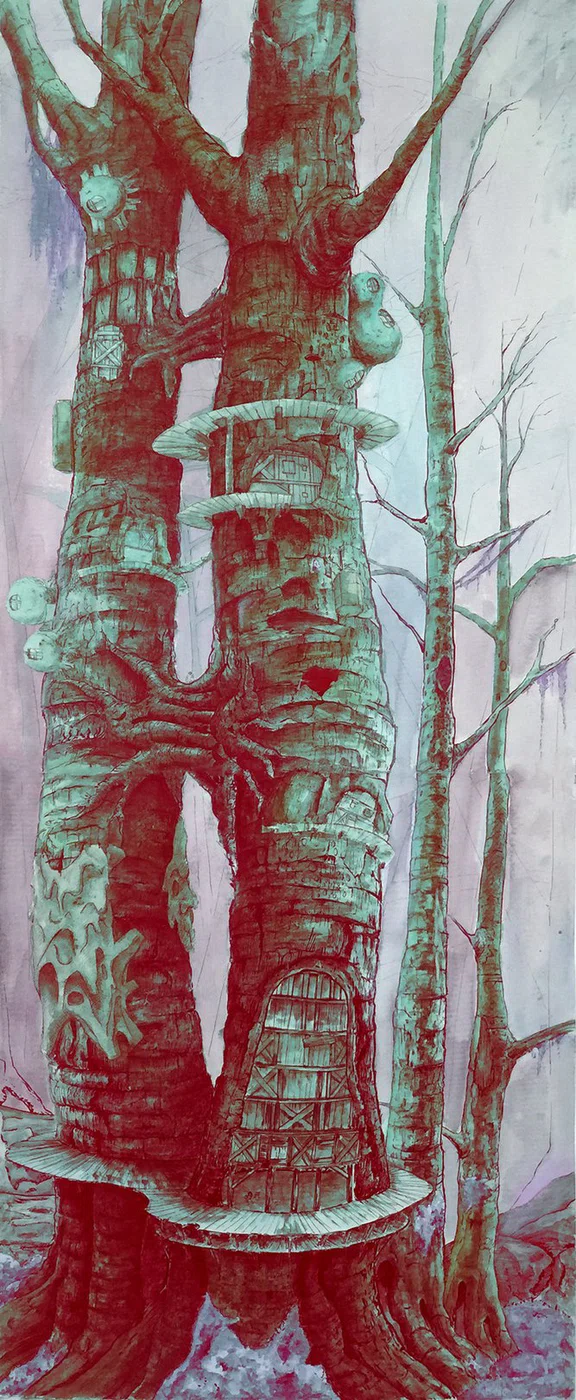




Kenneth
Qian
CONCORDIA International School Shanghai|Shanghai, China
TEACHER: Jane Klammer
Drawing

The piece was in part inspired from the concept of tree houses and how we can build structures intertwined with nature, as well my interest towards large shapes and forms in relation to smaller objects.

Untitled | 37 x 15 in.
Idea(s): A exaggerated environment in which people have constructed a house within the giant tree to live in
Materials(s): India Ink, Photoshop, Watercolor, Tubed Gouache, Pastel Stick
Process(es): After inking and coloring the piece, the colors felt plain so I edited the colors using photoshop
Student statement
Student
statement
Kenneth Qian
The artwork focuses on two large trees in a forest, joined together through large connecting branches and covered in many man-made structures built by those who call the tree home. The piece was in part inspired from the concept of tree houses and how we can build structures intertwined with nature, as well my interest towards large shapes and forms in relation to smaller objects.
The environment piece was made through the use of ink, watercolor and a little bit of pastel and gouache. The general large forms were made before working on smaller parts, adding in smaller detail and shading through the use of crosshatching. Another interest was texture in the piece which was supported through the use of crosshatching and pastel. After finishing coloring the piece, I found that the color usage on the piece was simple and generic, so I brought it into photoshop and did some color adjustments to reach a color scheme I enjoyed.
Teacher
statement
Jane Klammer
Highly articulate, highly organized, Kenneth rarely disappoints. He consistently maintains a high standard of quality and finishes especially in the completion of his APAD inquiry, “Strange and Weird Environments.” Observational and imaginative to an extremely high degree, Kenneth has been creating large illustrative drawings with expressive mark-making and precision throughout his high school years. He truly understands the spatial world and knows how to render it with depth and illumination.
What is the key to unlocking the unconscious mind in the effort to create conscious works of art?
Kenneth practices the art of automatism-creating art without conscious thought, accessing material from the unconscious mind as part of the creative process through many of his artworks, especially these landscapes. Kenneth’s face stays inches above the paper and he makes the ever-moving line flow, both by employing the ink cartridge ballpoint pen, the watercolor/ink brush, and then often, the digital ink pen stylus. He devotes much time to practice, experimentation and revision. After multiple practice attempts, he settles on creating each strange and weird environment with a ballpoint pen on paper. Multiple revisions usually occur again, as many results are not to his satisfaction. Lines, thick, thin, undulating, express his creative process and satisfaction is apparent as colored ink, gouache, watercolor, and pastel are added by hand, then embellished by digital means. When Kenneth arrives at a finish, his compositions present worldly landscapes that are warm and inviting, similar to the world around us while warping the landforms with pen and brush. While he is quickly growing in the development of digital means, Kenneth maintains his passion for the traditional means of art creation…the flow of the ink and color through the use of pen point and the paintbrush—traditional and digital.
What did you learn from working with this student?
Kenneth has the passion and drive to make art his life’s work. He took every possible class, our high school curriculum offers. He was involved with art studios and portfolio development courses outside of school. His parents strongly support him in developing his artistic abilities.
How did you scaffold writing into the artmaking and thinking processes?
Required reading of Art Fundamentals Textbooks. Each slide/artwork submission must include 100 written word statement. Mind-mapping the Introductory Paragraph (s) for each APAD portfolio description. A thorough understanding of these core art vocabulary lists and applications is essential for students’ and teachers’ paths to success.
How did you support skill development AND inquiry in the AP Art and Design curriculum?
Study art history and pull in known artists’ work. Get involved with their inquiries, but don’t control them or overwhelm them with suggestions. Visit galleries to see real art and websites. Help students recognize mature and advanced skill development in the work of others and what drives the inquiry evident within each piece. Not just create questions, but recognize intent and purpose.
How did you structure practice, experimentation, and revision into your AP Art and Design curriculum?
Primarily through sketchbook work. The collection of students/ artwork in action photos. Students needed to know that these were non-negotiable components—practice, experimentation, and revision—for the APAD portfolio. I also recognize that I need to teach this mantra within all my courses-no matter what level, so that students could apply it with maturity as they developed their inquiry.
What kinds of formative and summative assessments helped guide your students through your AP Art and Design curriculum?
Use of the APAD rubric when assessing their work. A regular revisiting of the AP Art & Design website, studying exemplars, individual and group critiques.
What kind of creative programming?
Use of the APAD videos, watching along my students.
Is there anything your school principal does to support your art students or art program?
Approves budget requests, supports framing and display needs, visits the AP class often to view our students’ work.
What is your advice to other AP Art and Design teachers?
We are the time managers. Establish a time schedule and stand firm with expectations-deadlines, quality, completion.
Kenneth Qian







